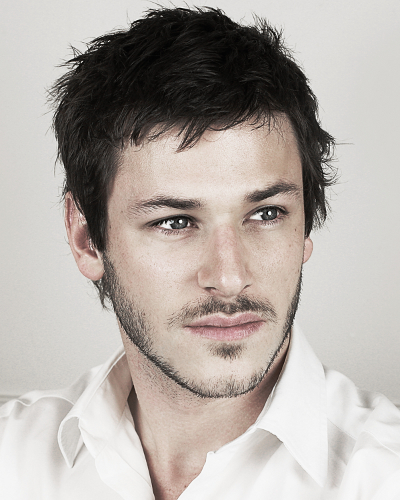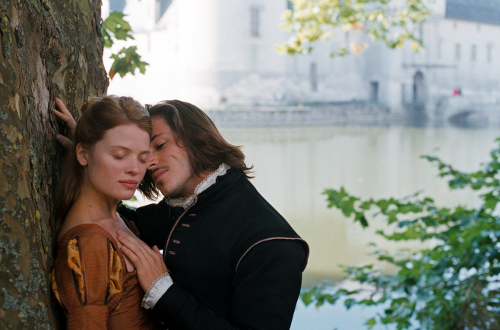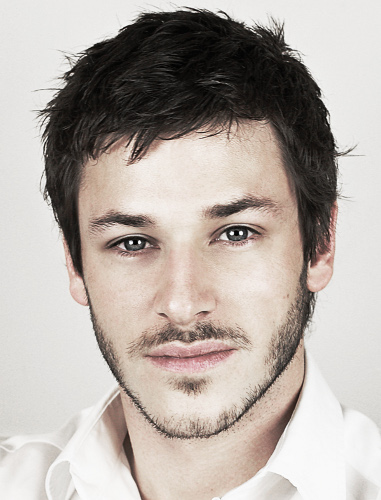
Gaspard Ulliel, above. Photo by Nora Schaefer, used with permission.
While playing a French historical character with the nickname of "le Balafré," or "the Scarred," in his new film The Princess of Montpensier, actor Gaspard Ulliel also risked his own famous features during the shooting of some of the film's highly realistic fight scenes. Although Ulliel does, in fact, sport a small scar on his left cheek from an accident with a dog when he was a child, the marks carried by his young warrior character in the film, the Duc de Guise, are considerably more pronounced, which isn't surprising when you see Ulliel as the Duc in the heated battle scenes of Princess.

Gaspard Ulliel in The Princess of Montpensier, above.
Directed by legendary filmmaker Bertrand Tavernier ('Round Midnight), The Princess of Montpensier takes place during the French Wars of Religion of the 1500s, and the director opted not to use many stuntmen, so when Ulliel's Duc intensely fights on foot, or on horseback, it really is the young actor performing those scenes. During one highly memorable sword duel that proceeds down a staircase and into a courtyard, Ulliel engages with fellow actor Grégoire Leprince-Ringuet, who portrays the historical figure of the Prince of Montpensier, in a fight composed by Tavernier using raw, long takes, without cutting away from the moments in which the actors stumble, or miss a thrust. As a result of this fly-on-the-wall approach, the fights in Princess appear genuinely dangerous, and they potentially were, requiring Ulliel to train for two months prior to shooting with martial arts expert Alain Figlarz. Recalling the moment when he came closest to injury, Ulliel says, "In the fight with the Prince, in the courtyard, his knife went into my mouth and cut me a little. The blades were not sharp, so it was okay!" A good thing for many reasons, including the fact that Ulliel is also the current male face of Chanel and can be seen today on thousands of billboards, and assorted advertisements, around the world.

Melanie Thierry and Gaspard Ulliel, above, in The Princess of Montpensier.
After acting in television, and also attending the University of Saint-Denis, where he majored in cinema, Ulliel broke into feature film acting with a small part in 2001's Brotherhood of the Wolf. In 2004, he then attained greater prominence in the United States, via his leading role opposite Audrey Tautou in the worldwide hit A Very Long Engagement, which earned him the French Cesar Award for Best Newcomer. He went on to play the young Hannibal Lecter in 2007's Hannibal Rising in the U.S., and co-star in international productions with the likes of Jean Reno in Le Premiere Circle, and Isabelle Huppert in Barrage Contre Le Pacifique.
Based on a short 17th century novel by Madame de la Fayette, The Princess of Montpensier centers on a young beauty named Marie de Mézières (played by Mélanie Thierry), who is poised to inherit one of the country's greatest fortunes. Although she loves Ulliel's Duc de Guise, Marie is married off to the Prince of Montpensier for financial and political purposes. As the Wars of Religion rage, Marie finds that her affections have become the prize of a much smaller battle, between the Duc de Guise, the Prince, and the Duc d'Anjou (played by Raphael Personnaz), who will one day ascend the throne as King Henry III. Acting as Marie's confidante and tutor is an older warrior, the Comte de Chabannes (Lambert Wilson), who abandoned the battlefield after killing a pregnant woman, and hopes to teach the young Marie the value of an open and inquisitive mind.

Lambert Wilson and Gaspard Ulliel, above, in The Princess of Montpensier.
Tavernier manages to imbue Princess with an energy that is often missing in period productions, in which everyone from the performers to the set designers often seem to be very aware that they're making a film set in the distant past. By contrast, Princess feels as if the cameras were just sort of dropped into this earlier century and began capturing pieces of it. Ulliel elaborates on some of the elements that give Princess a more modern feel:
"When you see period films, it tends to often be with older actors. Here, you have all these younger actors and that gives a lot of energy and a modern feeling. At the same time, usually, 'period film' means really precise filming with [dolly] tracks, and it feels stiff at some point. But here, Bertrand wanted to film this more like a documentary, in a way. He would be in the middle of the set with handheld shots and action."

Gaspard Ulliel, above. Photo by Nora Schaefer, used with permission.
Becoming the male face of Chanel had the side consequence of giving Ulliel the opportunity to work with another legendary filmmaker, Martin Scorsese, who directed Ulliel last year in the highly stylized, extended commercial for the Bleu de Chanel fragrance. Although Ulliel experienced fame prior to working with Chanel, he wasn't quite prepared for the level of exposure he received once the first Chanel campaigns launched. He recollects:
"This was a bit odd. When I signed for this, and was shooting the ad and doing the photo shoot, I knew there would be billboards and posters in the street, but not as much as they did. I mean, in France, it was everywhere, and I was a bit frightened in the beginning. You walk in the street and you see yourself everywhere."
Ulliel laughs and indicates his new, tightly-trimmed hairstyle, a significant change from the longish, flowing locks he sports in Princess and the Chanel advertisements, noting, "Maybe that's why I cut my hair." But, he then adds, "In the end, you just get used to it and you can walk past those posters and you don't really see them anymore."
The Princess of Montpensier premieres theatrically in the United States on April 15th, and will be available everywhere via Sundance Selects's Video-On-Demand program starting on April 22nd. The official movie site is reachable here.